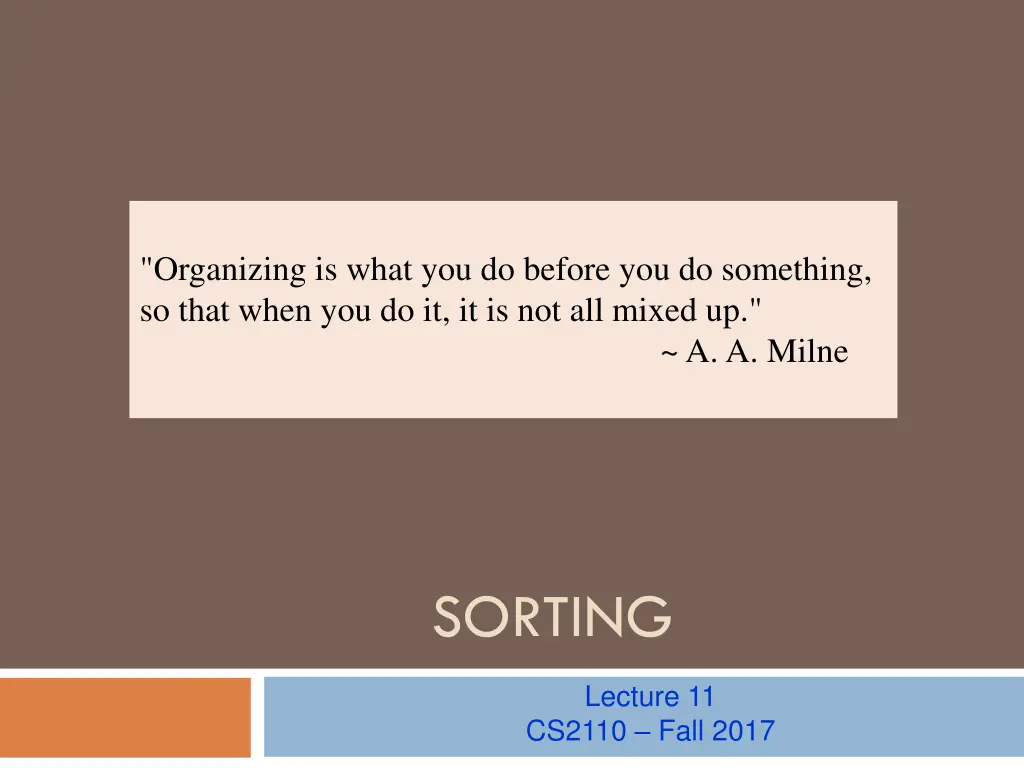
Effective Organizing Before Action: Tips from A.A. Milne
Learn the importance of organizing before undertaking tasks to avoid confusion and ensure efficiency. Discover insights on sorting, teaching opportunities, upcoming events, and discussions on sorting algorithms.
Download Presentation

Please find below an Image/Link to download the presentation.
The content on the website is provided AS IS for your information and personal use only. It may not be sold, licensed, or shared on other websites without obtaining consent from the author. If you encounter any issues during the download, it is possible that the publisher has removed the file from their server.
You are allowed to download the files provided on this website for personal or commercial use, subject to the condition that they are used lawfully. All files are the property of their respective owners.
The content on the website is provided AS IS for your information and personal use only. It may not be sold, licensed, or shared on other websites without obtaining consent from the author.
E N D
Presentation Transcript
"Organizing is what you do before you do something, so that when you do it, it is not all mixed up." ~ A. A. Milne SORTING Lecture 11 CS2110 Fall 2017
Announcements 2 is a program with a teach anything, learn anything philosophy. You will be able to provide high schoolers with instruction in the topic of your choice. This semester s event is on Saturday, November 4 Apply to be a teacher! If you are interested, please email us at: splashcornell@ gmail.com.
Prelim 1 4 It's on Thursday Evening (9/28) Two Sessions: 5:30-7:00PM: A..Lid 7:30-9:00PM: Lie..Z Three Rooms: We will email you Thursday morning with your room Bring your Cornell ID!!!
A3 5 120 100 80 60 40 20 0 <1 1 2 3 4 5 6 7 8 9 10 11 12 13 14 15 16 17 18 19 20 21
A3 Comments 7 /* Mini lecture on linked lists would have been very helpful. I still do not * know when we covered this topic in class. It was initially difficult to what we were meant to do without having learned the topic * in depth before */ * understand /* Maybe the assignment guide could explain a bit more about how to * thoroughly test the methods though. Testing is still a bit difficult and I * wish we had an assignment which covered that more. The instructions * could have been more specific about what is expected from the test * cases though. */ /* It also showed me how important it is to test after writing a method. I * had messed up on one of the earlier methods and if I had waited to test * I would have had a
Why Sorting? 8 Sorting is useful Database indexing Operations research Compression There are lots of ways to sort There isn't one right answer You need to be able to figure out the options and decide which one is right for your application. Today, we'll learn about several different algorithms (and how to derive them)
Some Sorting Algorithms 9 Insertion sort Selection sort Merge sort Quick sort
InsertionSort 10 0 b.length ? 0 b.length sorted pre:b post:b 0 i b.length sorted ? A loop that processes elements of an array in increasing order has this invariant b inv: or: b[0..i-1] is sorted
Each iteration, i= i+1; How to keep inv true? 11 0 i b.length sorted ? b inv: 0 i b.length 2 5 5 5 7 3 ? e.g. b 0 2 3 5 5 5 7 i b.length ? b
What to do in each iteration? 12 12 0 i b.length sorted ? b inv: 0 i b.length 2 5 5 5 7 3 ? e.g. b 2 5 5 5 37 ? Push b[i] to its sorted position in b[0..i], then increase i Loop body 2 5 5 35 7 ? (inv true before and after) 2 5 35 5 7 ? 2 35 5 5 7 ? 0 i b.length 2 3 5 5 5 7 ? This will take time proportional to the number of swaps needed b
Insertion Sort 13 // sort b[], an array of int // inv: b[0..i-1] is sorted for (int i= 0; i < b.length; i= i+1) { // Push b[i] down to its sorted // position in b[0..i] Note English statement in body. Abstraction. Says what to do, not how. This is the best way to present it. We expect you to present it this way when asked. Present algorithm like this Later, can show how to implement that with an } inner loop
Insertion Sort 14 invariant P: b[0..i] is sorted except that b[k] may be < b[k-1] k // sort b[], an array of int // inv: b[0..i-1] is sorted for (int i= 0; i < b.length; i= i+1) { // Push b[i] down to its sorted // position in b[0..i] while (k > 0 && b[k] < b[k-1]) { Swap b[k] and b[k-1] i 2 5 35 5 7 ? example int k= i; start? stop? k= k 1; progress? } } maintain invariant?
Insertion Sort 15 // sort b[], an array of int // inv: b[0..i-1] is sorted for (int i= 0; i < b.length; i= i+1) { Push b[i] down to its sorted position in b[0..i] } Let n = b.length Worst-case: O(n2) (reverse-sorted input) Best-case: O(n) (sorted input) Pushing b[i] down can take i swaps. Worst case takes 1 + 2 + 3 + n-1 = (n-1)*n/2 Swaps. Expected case: O(n2)
Performance 16 Algorithm Algorithm Time Time Space Space Stable? Stable? ?(?) to ?(?2) ?(?) to ?(?2) ?(?2) Insertion Sort Insertion Sort Yes Yes ?(1) ?(1) Merge Sort Selection Sort No ?(1) Quick Sort Merge Sort Quick Sort
SelectionSort 17 0 b.length ? 0 b.length sorted pre: b post:b 0 i b.length sorted , <= b[i..] >= b[0..i-1] inv:b Additional term in invariant Keep invariant true while making progress? 0 i b.length 1 2 3 4 5 6 9 9 9 7 8 6 9 e.g.: b Increasing i by 1 keeps inv true only if b[i] is min of b[i..]
SelectionSort Another common way for people to sort cards //sort b[], an array of int // inv: b[0..i-1] sorted AND // b[0..i-1] <= b[i..] for (int i= 0; i < b.length; i= i+1) { int m= index of minimum of b[i..]; Swap b[i] and b[m]; } 18 Runtime with n = b.length Worst-case O(n2) Best-case O(n2) Expected-case O(n2) 0 i length b sorted, smaller values larger values Each iteration, swap min value of this section into b[i]
Performance 19 Algorithm Time Space Stable? ?(?) to ?(?2) ?(?2) Insertion Sort Yes ?(1) Selection Sort No ?(1) Merge Sort Quick Sort
Merge two adjacent sorted segments 20 /* Sort b[h..k]. Precondition: b[h..t] and b[t+1..k] are sorted. */ public static merge(int[] b, int h, int t, int k) { } h t k h t k b sorted sorted 4 7 7 8 9 3 4 7 8 h k b 3 4 4 7 7 7 8 8 9 merged, sorted
Merge two adjacent sorted segments 21 /* Sort b[h..k]. Precondition: b[h..t] and b[t+1..k] are sorted. */ public static merge(int[] b, int h, int t, int k) { Copy b[h..t] into a new array c; Merge c and b[t+1..k] into b[h..k]; } h t k h t k b sorted sorted 4 7 7 8 9 3 4 7 8 h k b 3 4 4 7 7 7 8 8 9 merged, sorted
Merge two adjacent sorted segments 22 // Merge sorted c and b[t+1..k] into b[h..k] 0 t-h pre: h t k c b x, y are sorted x ? y h k post: b x and y, sorted 0 i c.length invariant: c head of x tail of x h u v k b tail of y ? head of x and head of y, sorted
Merge 23int i = 0; int u = h; int v = t+1; while( i < t-h){ if(v < k && b[v] < c[i]) { b[u] = b[v]; u++; v++; }else { b[u] = c[i]; u++; i++; } } h t k 0 t-h pre: c b ? sorted sorted h k post: b sorted inv: 0 i c.length c sorted sorted h u v k b sorted sorted ?
Mergesort 24 /** Sort b[h..k] */ public static void mergesort(int[] b, int h, int k]) { if (size b[h..k] < 2) return; int t= (h+k)/2; mergesort(b, h, t); mergesort(b, t+1, k); merge(b, h, t, k); } h t k sorted sorted h k merged, sorted
Performance 25 Algorithm Algorithm Time Time Space Space Stable? Stable? ?(?) to ?(?2) ?(?) to ?(?2) ?(?2) Insertion Sort Insertion Sort Yes Yes ?(1) ?(1) Merge Sort Selection Sort Yes No ? log(?) ?(?) ?(1) Quick Sort Merge Sort Yes ? log(?) ?(?) Quick Sort
QuickSort 26 Quicksort developed by Sir Tony Hoare (he was knighted by the Queen of England for his contributions to education and CS). 83 years old. Developed Quicksort in 1958. But he could not explain it to his colleague, so he gave up on it. Later, he saw a draft of the new language Algol 58 (which became Algol 60). It had recursive procedures. First time in a procedural programming language. Ah!, he said. I know how to write it better now. 15 minutes later, his colleague also understood it.
Partition algorithm of quicksort 27 h h+1 k x is called the pivot x ? pre: Swap array values around until b[h..k] looks like this: h j k post: <= x x >= x
20 31 24 19 45 56 4 20 5 72 14 99 28 partition j pivot 19 4 5 14 20 31 24 45 56 20 72 99 Not yet sorted Not yet sorted these can be in any order these can be in any order The 20 could be in the other partition
Partition algorithm 29 h h+1 k b x ? pre: h j k post: b <= x x >= x invariant needs at least 4 sections Combine pre and post to get an invariant h j t k <= x x ? >= x b
Partition algorithm 30 h j t k Initially, with j = h and t = k, this diagram looks like the start diagram <= x x ? >= x b j= h; t= k; while (j < t) { if (b[j+1] <= b[j]) { Swap b[j+1] and b[j]; j= j+1; } else { Swap b[j+1] and b[t]; t= t-1; } } Terminate when j = t, so the ? segment is empty, so diagram looks like result diagram Takes linear time: O(k+1-h)
QuickSort procedure /** Sort b[h..k]. */ publicstaticvoid QS(int[] b, int h, int k) { if (b[h..k] has < 2 elements) return; int j= partition(b, h, k); // We know b[h..j 1] <= b[j] <= b[j+1..k] 31 Base case Function does the partition algorithm and returns position j of pivot // Sort b[h..j-1] and b[j+1..k] QS(b, h, j-1); QS(b, j+1, k); } h j k <= x x >= x
Worst case quicksort: pivot always smallest value j n 32 x0 >= x0 j partioning at depth 0 partioning at depth 1 x0 x1 >= x1 j partioning at depth 2 x0 x1 x2 >= x2 Depth of recursion: O(n) /** Sort b[h..k]. */ publicstaticvoid QS(int[] b, int h, int k) { if (b[h..k] has < 2 elements) return; int j= partition(b, h, k); QS(b, h, j-1); QS(b, j+1, k); Processing at depth i: O(n-i) O(n*n)
Best case quicksort: pivot always middle value 33 0 j n depth 0. 1 segment of size ~n to partition. <= x0 x0 >= x0 Depth 2. 2 segments of size ~n/2 to partition. Depth 3. 4 segments of size ~n/4 to partition. <=x1 x1 >= x1 x0 <=x2 x2 >=x2 Max depth: O(log n). Time to partition on each level: O(n) Total time: O(n log n). Average time for Quicksort: n log n. Difficult calculation
QuickSort complexity to sort array of length n Time complexity Worst-case: O(n*n) Average-case: O(n log n) 34 /** Sort b[h..k]. */ publicstaticvoid QS(int[] b, int h, int k) { if (b[h..k] has < 2 elements) return; int j= partition(b, h, k); // We know b[h..j 1] <= b[j] <= b[j+1..k] // Sort b[h..j-1] and b[j+1..k] QS(b, h, j-1); QS(b, j+1, k); } --depth of recursion can be n Can rewrite it to have space O(log n) Show this at end of lecture if we have time Worst-case space: ? What s depth of recursion? Worst-case space: O(n)!
QuickSort versus MergeSort 35 35 /** Sort b[h..k] */ publicstaticvoid QS (int[] b, int h, int k) { if (k h < 1) return; int j= partition(b, h, k); QS(b, h, j-1); QS(b, j+1, k); } /** Sort b[h..k] */ publicstaticvoid MS (int[] b, int h, int k) { if (k h < 1) return; MS(b, h, (h+k)/2); MS(b, (h+k)/2 + 1, k); merge(b, h, (h+k)/2, k); } One processes the array then recurses. One recurses then processes the array.
Partition. Key issue. How to choose pivot 36 h h k Choosing pivot Ideal pivot: the median, since it splits array in half But computing is O(n), quite complicated b x ? pre: h j k post: b <= x x >= x Popular heuristics: Use first array value (not so good) middle array value (not so good) Choose a random element (not so good) median of first, middle, last, values (often used)!
Performance 37 Algorithm Time Space Stable? ?(?) to ?(?2) ?(?2) Insertion Sort Yes ?(1) Selection Sort No ?(1) Merge Sort Yes ? log(?) ?(?) ?log(?) to ?(?2) Quick Sort No ?(log ? )
Sorting in Java 38 Java.util.Arrays has a method Sort() implemented as a collection of overloaded methods for primitives, Sort is implemented with a version of quicksort for Objects that implement Comparable, Sort is implemented with mergesort Tradeoff between speed/space and stability/performance guarantees
Quicksort with logarithmic space 39 Problem is that if the pivot value is always the smallest (or always the largest), the depth of recursion is the size of the array to sort. Eliminate this problem by doing some of it iteratively and some recursively. We may show you this later. Not today!
QuickSort with logarithmic space 40 /** Sort b[h..k]. */ publicstaticvoid QS(int[] b, int h, int k) { int h1= h; int k1= k; // invariant b[h..k] is sorted if b[h1..k1] is sorted while (b[h1..k1] has more than 1 element) { Reduce the size of b[h1..k1], keeping inv true } }
QuickSort with logarithmic space 41 /** Sort b[h..k]. */ publicstaticvoid QS(int[] b, int h, int k) { int h1= h; int k1= k; // invariant b[h..k] is sorted if b[h1..k1] is sorted while (b[h1..k1] has more than 1 element) { int j= partition(b, h1, k1); // b[h1..j-1] <= b[j] <= b[j+1..k1] if (b[h1..j-1] smaller than b[j+1..k1]) { QS(b, h, j-1); h1= j+1; } else {QS(b, j+1, k1); k1= j-1; } } } Only the smaller segment is sorted recursively. If b[h1..k1] has size n, the smaller segment has size < n/2. Therefore, depth of recursion is at most log n





